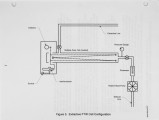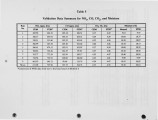| OCR Text |
Show determination of the aldehydes.4,s Since N02 can be present in engine exhaust, it is a possible interferant to the DNPH based measurement methods . . Laboratory spiking studies conducted in this program using the extractive FTIR system consistently resulted in excellent agreement with calculated concentrations. The data showed recoveries at or greater than 90 percent for the spiked aldehydes (formaldehyde, acetaldehyde, and acrolein) through the entire sample extraction and analysis system. Therefore, GRI conducted a test to validate the extractive FTIR method for formaldehyde, acetaldehyde and acrolein according to EPA Method 301 -- Field Validation of Pollutant Measurement Methods from Various Waste Media.6 Since the FTIR instrument can measure multiple species simultaneously, on a continuous and realtime basis, other compounds including oxides of nitrogen (NOx; NO plus N02), carbon monoxide (CO), carbon dioxide (C02), and moisture were included as target compounds in the validation test. This paper summarizes the results from this validation testing effort. Detailed description of the results can be found in Reference 7. EXPERIMENTAL Approach For validation of the aldehydes, the analyte spiking procedure ill Method 301 was used, as consistent with the validation testing conducted by EPA to validate the extractive FTIR method for air toxics compounds from coal-fired boilers.8 For all measurements, a slip stream of the engine exhaust was extracted through a sample probe in a 3-inch port from a horizontal section of the exhaust pipe prior to the muffler and transferred through a heat traced line and heated pumps directly to the FTIR instrument (see Figure 1). An insulated orifice tube was placed in line immediately after the sample probe to measure gas flow rate, as shown in Figure 2. The heated spiking tee used to inject aldehyde standards was placed inline after the orifice tube. An insulated box containing a calibration solenoid for the addition of other gas standards was included in the sample system. A 100-ft long multi-tube heat traced teflon sample line was used to deliver the sample gas to the mobile laboratory for analysis. For validation of the other target compounds, a paired sampling system was employed according to Method 301. A direct comparison was made between the FTIR data and the data collected using the applicable EPA reference methods (Methods 7E, 10, 3A, and 4 for NOX' CO, CO2, and moisture, respectively). Sample conditioning for the reference method instruments consisted of removal of moisture using chilled condenser maintained at 35...±.2°F. Moisture samples were collected from a slip stream of the unconditioned sample in chilled impingers according to EPA Method 4. Measurement System Components A Nicolet Model RS-3 FTIR bench, custom modified with a heated cell, was used for the validation (see Figure 3). The variable pathlength cell consisted of a 32-inch mirror system inside of a 4-inch ID stainless steel tube (Infrared Analysis, Model 4-32-AU). The instrument was equipped with a Nicolet MCf-A detector. Gold coated glass mirrors were used to avoid degradation of the mirror surfaces due to moisture or any acid gases in the exhaust stream. The FfIR cell pathlength was set at 10.8 meters to obtain maximum sensitivity for the target pollutants while minimizing interferences from water and carbon dioxide. The cell pathlength was 2 |




















